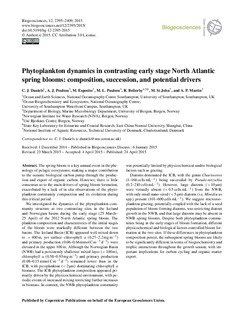| dc.description.abstract | The spring bloom is a key annual event in the phenology of pelagic ecosystems, making a major contribution to the oceanic biological carbon pump through the production and export of organic carbon. However, there is little consensus as to the main drivers of spring bloom formation, exacerbated by a lack of in situ observations of the phytoplankton community composition and its evolution during this critical period. We investigated the dynamics of the phytoplankton community structure at two contrasting sites in the Iceland and Norwegian basins during the early stage (25 March– 25 April) of the 2012 North Atlantic spring bloom. The plankton composition and characteristics of the initial stages of the bloom were markedly different between the two basins. The Iceland Basin (ICB) appeared well mixed down to >400 m, yet surface chlorophyll a (0.27–2.2 mgm�����3) and primary production (0.06–0.66 mmol Cm�����3 d�����1) were elevated in the upper 100 m. Although the Norwegian Basin (NWB) had a persistently shallower mixed layer (<100 m), chlorophyll a (0.58–0.93 mgm�����3) and primary production (0.08–0.15 mmolCm�����3 d�����1) remained lower than in the ICB, with picoplankton (<2 μm) dominating chlorophyll a biomass. The ICB phytoplankton composition appeared primarily driven by the physicochemical environment, with periodic events of increased mixing restricting further increases in biomass. In contrast, the NWB phytoplankton community was potentially limited by physicochemical and/or biological factors such as grazing. Diatoms dominated the ICB, with the genus Chaetoceros (1–166 cellsmL�����1) being succeeded by Pseudo-nitzschia (0.2–210 cellsmL�����1). However, large diatoms (>10 μm) were virtually absent (<0.5 cellsmL�����1) from the NWB, with only small nano-sized (<5 μm) diatoms (i.e. Minidiscus spp.) present (101–600 cellsmL�����1). We suggest microzooplankton grazing, potentially coupled with the lack of a seed population of bloom-forming diatoms, was restricting diatom growth in the NWB, and that large diatoms may be absent in NWB spring blooms. Despite both phytoplankton communities being in the early stages of bloom formation, different physicochemical and biological factors controlled bloom formation at the two sites. If these differences in phytoplankton composition persist, the subsequent spring blooms are likely to be significantly different in terms of biogeochemistry and trophic interactions throughout the growth season, with important implications for carbon cycling and organic matter export. | nb_NO |

